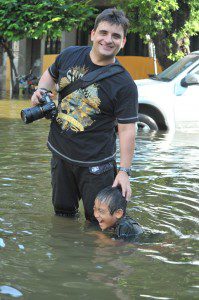The ethics of staging
Lifting the curtain on the rights and wrongs of recreating scenes for TV news.

Freelance reporter Tibor Krausz during floods in Thailand last year.
Photograph courtesy of Tibor Krausz
Last November, Thailand was suffering through its worst flooding in 50 years. While Thai citizens are no strangers to high water levels, the heavy monsoon rains had left more than 800 dead and thousands displaced. As a result, television news crews from around the world were on the ground to put a human face to the natural disaster. In the midst of it all, Hungarian-born freelance reporter and Carleton University alumnus Tibor Krausz ventured from his home in Bangkok into the flooded streets of the city to take some photographs.
It was just after 7 a.m. when he arrived right outside of the city’s Chinatown, a neighbourhood east of the overflowing Chao Phraya River. Krausz was surprised at what he saw. “Even though the water was basically knee deep, or even deeper,” he says, “people just tried to go about their lives.” A similar scene greeted him near the Grand Palace, where street vendors continued selling food. Some children were even swimming in the knee-deep water, enjoying an impromptu pool party.
But in one section of the street, Krausz saw a small group of Thais standing on sandbags surrounded by water, looking at their feet, hesitant to cross. A British television reporter stood nearby, explaining to the camera that the people were burdened with the question of whether to cross the harrowing street. Just off camera, meanwhile, the children continued frolicking in the water.
Once he was finished recording, the reporter thanked the locals, who stepped back into the flooded street without hesitation and continued on their way. Krausz approached the crew, identified himself as a fellow journalist, and asked why they had staged the report. Upset at being questioned, the reporter replied, “Well, have you done any television journalism?” Krausz took that to mean that such staging was a common occurrence.
Five minutes later, while wandering through a small market, he saw just how common it was. A Thai camera crew had asked a group of soldiers to stack sandbags and was filming the scene, at one point telling the men to stop and start over. Apparently, the crew felt one of the soldiers was smiling too much. It took two more takes until the reporters were satisfied.
Krausz wrote about the two staging incidents for The Christian Science Monitor, admitting it felt strange to report on fellow journalists. “I think a lot of journalists, they have this sort of omertà, you know, like the Italian Mafia’s code of silence, that you would not actually speak about other journalists,” he says. “And even myself, I didn’t feel good about this. But I think sometimes you have to speak up.”
As to when you should speak up, however, it’s not always clear. For Krausz, the motivation was simple: in staging scenes for their cameras, the journalists were needlessly distorting the reality of what was actually happening on the ground in Thailand.
But what about the far more widespread practice of shooting B-roll—or sequencing shots—for news reports, when the journalist asks the subject to pretend to answer a phone call or walk down a hallway for the camera, for example? Such innocuous, generic scenes are regularly spliced into news reports, but they’re no more real than the footage of Thais feigning fear in the flooded streets of Bangkok.
While most television journalists have no problem with the staging of generic footage for news reports, there are detractors. Their argument? By allowing the creation of such everyday scenes, broadcasters are leaving the door open for reporters to push the boundaries of what is acceptable—and in the process, diminish the credibility of television journalism.
•••
Anybody who stages always has excuses, okay? And they’re all bullshit.” So proclaims Wolfgang Achtner during a lively cross-Atlantic Skype conversation. The Italy-based journalist has worked for networks such as ABC and CNN over the course of his 30-year career, but he says he’s never resorted to staging—and never will. “I have been told by some colleagues that I’m a hard-ass and that my position is unnecessarily rigid, but I don’t agree,” he says. “I’ve always done a great job and beaten anyone at any aspect of journalism, whether it was as a photographer or writer or video journalist.”
Achtner, who has taught journalism in universities across Italy, believes there must be a clear separation between fiction and journalism. In fiction, he says, you can film whatever you want, as many times as you want, to achieve the desired footage; when you’re shooting news, however, you’re shooting events as they happen. “Staging something would put us into the fiction camp. It’s taboo for me—a line I will not ever cross.”
Predictably, Achtner’s stance has led to conflicts with other journalists, especially since he’s reproached colleagues in the field over what he considers unethical behaviour. The way he sees it, reporters stage due to sloppiness or laziness—sloppiness meaning they missed something because they weren’t paying attention, and laziness because they weren’t willing to spend the time to find something occurring naturally.
“When people say, ‘Well, I can’t wait for three hours in a place to get one person walking in front of an archway,’ well, then don’t do it and go get something else that you believe is more important,” Achtner says. What you can’t do, he argues, is ask someone to walk in front of the archway in order to create the footage you envisioned. If it doesn’t happen spontaneously, he says, tough luck. “You do without that shot. Period.”
Certainly, there are examples supporting Achtner’s contention that staging is unnecessary. Take the case of OMNI News’s South Asian Edition reporter Aadel Haleem and camera operator Gary Chow. Last November, around the same time journalists were fabricating scenes in the flooded streets of Bangkok, the pair was in Toronto preparing a piece on immigration. As Haleem chatted with a lawyer in a downtown boardroom, Chow quietly recorded the exchange, spending the next 10 minutes manoeuvring around the long boardroom table in order to take a variety of different shots to serve as B-roll for the report.
After Haleem completed the formal interview, the pair packed up and headed back to their Toronto studio, carrying with them plenty of footage for their report—all without a single instance of staging.
•••
Unlike Achtner, not all journalists think the television industry is suffering from an ethical blind spot over the staging of commonplace scenes. Trisha Doyle, who has taught journalism at the University of British Columbia, argues that asking someone to do something for the camera that is a normal part of their day may be acceptable. “Is having somebody walk down a hall staging? I don’t know. I imagine if the person walks down a hall on a daily basis, then it’s kind of a way to help the editing process,” she says. An Emmy Award-winning journalist who has worked for the like of ABC and CBS, Doyle believes viewers at home are not idiots; they can tell when a subject is doing something at the request of the reporter. “I think audiences are pretty sophisticated and know when we have somebody walk down the hallway, that’s just an editing tool that is used,” she says.
According to Doyle, the ethical boundary is breached when a journalist invents a scene for their report or requests their subject to do something he or she would not normally do over the course of their day. “For me, staging is when you put something on a car engine to make it blow up,” she explains. “You know, when otherwise it wouldn’t.”
Paul Adams, an associate professor of journalism at Ottawa’s Carleton University, holds a similar point of view to Doyle. He argues that the term “staging” should not be used to describe the practice of asking subjects to perform normal tasks such as walking down a hallway or typing on a keyboard for the camera. “I think every television reporter in my time, and I presume now, would say that you are absolutely not allowed to stage,” explains
Adams, who has worked both in broadcast and print as a reporter for The Globe and Mail and CBC’s The National. “But what we would mean by staging would be if people had been throwing rocks at cars, and you show up a minute or two late and say, ‘Could somebody just throw a rock at the car so I could get a picture of it?'” he contends.
Adams says that the mere presence of a television crew with a camera will affect how people act—they will either play to the camera or try to ignore it. Either way, he argues, they won’t be acting naturally. “Does what you present to the viewer distort reality or create a perception other than a truthful one?” he asks. In the case of a television reporter asking a subject to do run-of-the-mill actions such as walking down a hallway for the camera, at least, his answer is definitely no. Says Adams: “I don’t think the viewer is in any way misled by seeing an economist sitting at his computer for a couple shots.”
•••
Journalists do not need to navigate this to-stage-or-not-to-stage ethical minefield alone, as many media organizations offer guidelines on the practice. Unfortunately, they don’t always agree on where to draw the line—or even draw the line, for that matter.
John Long is the chairman of the ethics and standards committee of the U.S.-based National Press Photographers Association (NPPA). In order to protect the dwindling credibility of television news, he says, his organization has spoken out on many issues, including staging. In its code of ethics, the NPPA directs photographers and videographers not to “intentionally contribute to, alter, or seek to alter or influence events” while shooting their subjects.
Long says this guideline is key to ethical behaviour. “Our job is to record the reality in front of us so that we can present it to the reader or the viewer and say, ‘This is what I saw,'” he says. “We are not supposed to, in journalism, become a participant.” Long concedes, however, that television has different needs than print. “Video is after storytelling in temporal progression,” he says. Still, he says he would like to see far fewer staged shots used to tell the story. “I think it hurts us in the long run,” he observes. “How they’re going to get away from that, I don’t know.”
Unlike that of the NPPA, CBC/Radio-Canada’s code of ethics does not specifically spell out what is unacceptable in regards to staging. Instead, the broadcaster merely provides this guideline for shooting B-roll: “Generic scenes are commonly used in audiovisual production. These are often everyday actions like walking, answering the phone, looking at a document, closing a door. These scenes clearly serve as general illustration and in no way pretend to describe real facts precisely.”
Although the guideline provides examples, it remains subjective as to what exactly constitutes a generic scene. If the only precondition for directing subjects is that they must perform “everyday actions” to provide “general illustration,” arguably almost anything could be termed a generic scene. For some people, sitting at a desk and typing on a keyboard is an everyday scene. For others, it could very well be throwing rocks at riot police.
Then there’s the Association of Electronic Journalists, or RTDNA Canada, which provides the code of ethics used by the Canadian Broadcast Standards Council. Here’s how the organization tackles the practice of staging: “Electronic journalists will present news and information without distortion…. Electronic journalists will not present news that is rehearsed or re-enacted without informing the audience.”
This seems cut and dried, but RTDNA Canada’s president, Andy LeBlanc, says there must be a balance between providing such rules to prevent unethical behaviour and giving reporters freedom to report. LeBlanc, a television journalism instructor at New Brunswick Community College, says this grey area allows for open discussion and engagement in a newsroom: “I don’t know that we would want to have this massive code of ethics with 40,000 pages of absolute specifics, because that in itself might be restricting to the freedom of journalism by doing that. So I guess it’s a question of just how far should the rules go; you want to be sure that the principles are upheld.”
The key, says LeBlanc, is to support the ideals of truth, honesty, and authenticity, which are essential to ethics. “Circumstances change,” he says, “but the principles really don’t.”
•••
During his 40-year career as a videographer, Darrell Barton has seen first-hand how different newsrooms have handled staging, and he’s not optimistic about the way things are heading. Handy with a still camera since he was 14, Barton grew up with dreams of becoming a Life magazine photographer. While that never came to pass, he did become somewhat of a legend in the TV industry, earning around 60 awards for television photography and production. Among the honours? The NPPA’s Television News Cameraman of the Year Award, which he won in 1974 and again in 1981.
In 1984, Barton struck out on his own and started freelancing, often for CBS. It was there his philosophy on staging began to form, after reading the network’s code of ethics. “It said that if you stage something, you will be fired,” he says. “If you see somebody working for CBS and [they stage] anything and you don’t report them, you will be fired.”
For Barton, the edict made things simple: “You don’t ask anybody to step back. You don’t ask anybody to wait. You don’t ask anybody to ‘Let’s take a walk on the beach.’ You don’t do that. Period.” So no matter what a producer told him to shoot, he had this rule supporting him, saying he didn’t have to do it if it crossed the line.
How tightly did CBS regulate staging? In the 1971 edition of its operating standards, the network states the following: “There shall be no re-creation, no staging, no production technique which would give the viewer an impression of any fact other than the actual fact, no matter how minor or seemingly inconsequential…anything which gives the viewer an impression of time, place, event or person other than the actual fact as it is being recorded and broadcast cannot be tolerated.” The statement then goes on to read: “I recognize that strict application of this policy will result in higher costs or a less technically perfect or interesting ‘show’ in certain instances. But our field is journalism, not show business.”
As Barton describes it, this time at CBS was the golden age of journalism, when ethics ruled. But it did not last. He says that in 1999, he received an updated version of the standards and practices. At first glance, it read the same as the previous version—staging was not to be tolerated, and those caught doing so, or witnessing it and not reporting it, would be fired. But he says there was a small addition, allowing for the recording of “certain actions for production purposes.” (CBS News declined an interview.)
In effect, this meant CBS journalists were now able to set up scenes, if they fell under the blurry definition of “certain actions for production purposes.” For Barton, the new guideline changed everything. “I sent it back to them and said, ‘My standards are higher than this.'” He did not work for CBS often after that.
Now retired, Barton thinks TV news has stopped caring about credibility, and viewers are all too aware of this. A self-described “constructive pessimist,” he thinks staging is here to stay and will only hurt the industry in the long run. When the viewer believes everything is set up, he says, they will stop trusting the reports. His downbeat conclusion: “People aren’t taking news seriously anymore.”
Photograph of Wolfgang Achtner courtesy of Wolfgang Achtner. Illustration by Dan Page.
by Daniel Viola
This is a joint byline for the Ryerson Review of Journalism. All content is produced by students in their final year of the graduate or undergraduate program at the Ryerson School of Journalism.











































